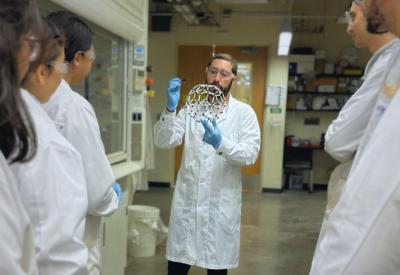Researchers from Wuhan University, University of South Florida, CNRS and Nanoneurosciences recently reported the first crystalline 2D Fullerene based Metal Halide Semiconductor, (C60-2NH3)Pb2I6.
Designing functionalized C60 adducts at the Spanopoulos Group at USF
According to the team, single crystal XRD studies elucidated the structure of the new material, while DFT calculations highlighted the strong contribution of C60-2NH3 to the electronic density of states of the conduction band of the material. Utilization of C60-2NH3 as an interlayer between a FA0.6MA0.4Pb0.7Sn0.3I3 perovskite and a C60 layer reportedly offered superior band energy alignment, reduced nonradiative recombination, and enhanced carrier mobility.
To investigate the effect of (C60-2NH3)Pb2I6 on the performance of perovskite solar cells (PSCs), the scientists prepared inverted (p-i-n) mixed Sn─Pb ideal bandgap PSCs. The reduced dielectric confinement within the material’s sublayers and the compound’s high affinity for adjacent device layers (perovskite and C60) promoted charge transport and reduced the number of traps, giving rise to a champion efficiency of 21.64%, maintaining 90% of its initial efficiency, after being stored under a N2 atmosphere for 2400 h.
This work sets the foundation for developing a new family of functional materials, namely Fullerene Metal Halide Semiconductors, targeting applications from photovoltaics to catalysis, transistors, and supercapacitors.


